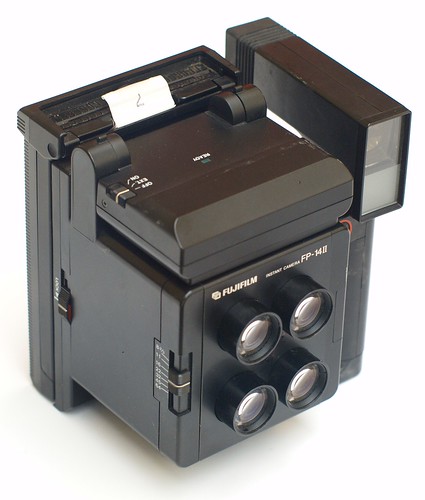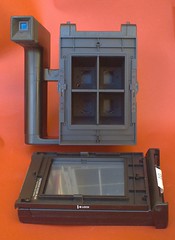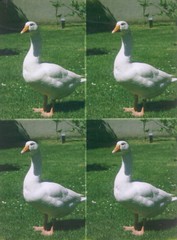Fujifilm FP-14 II

|
| image by Uwe Kulick (Image rights) |
The Fujifilm FP-14 II is a big black plastic viewfinder camera, surprisingly a professional one. It uses 8.5×10.8cm instant film packs of Fujifilm or Polaroid. The camera uses the full possible 7.3×9.5cm image format but divided in four rectangles. Like a Carte de Visite camera of portrait photography pioneer André-Adolphe-Eugène Disdéri it's actually four cameras in one. Each of the four cameras has an own portrait lens with own rhombical diaphragm and shutter. The lenses are of equal type (108mm portrait lenses) and all focused unchangably for portrait distance of 2 to 3 metres. One aperture selector sets all four diaphragms to the same aperture size, choosable between f8 2/3 and f64. The shutters are driven electrically and even flash synchronized all at once. Like in old Disdéri cameras the four cameras' dark chambers all share one image plane. Of course four shares of smaller format, just 47×36mm image frames, and with a sheet of modern pack film as shared image plane.

|

|

|
| images by Uwe Kulick (Image rights) | ||
The disadvantage of the FP-14 II is that it allows just shooting the four images all at once. Its advantage is the hinged strong electronic flash on its top which can be used instead of an external flash. Another advantage is the big grip fixed to bottom and left side of the camera's body which makes it independent from usage on a tripod. The grip also bears the telescopic reverse Galilean bright frame viewfinder and the electronic shutter release button, and it contains the four AA batteries which are necessary for the built-in flash and the motorized shutters. A third advantage is the detachable film pack back. Before detaching the back by means of the two shiftable locks on the sides a rectangular sheet metal cover can be shifted into the back so that a half-used film pack will be light-protected. Thus a photographer who owns a second film pack container can easily switch between black & white and color film.
usage and handling
1.
|
2.
|
3.
|
4.
|
5.
|
6.
|
| Film back and film pack images by Uwe Kulick (Image rights) | |||||

|
| finished image results image by Uwe Kulick (Image rights) |
When the metal sheet that covers the image plane is put into the film back most steps of handling the film can be done with detached film back:
- The film back can be opened for loading it with a new film pack.
- The black light seal paper must pulled out before the first exposure.
- The a paper stripe shows the number of the next exposure. For exposure the back must be attached to camera, and the image-plane-covering metal sheet must be pulled out of back when it is attached. After exposure the metal sheet can be pushed back into the back, and then the back can be detached again.
- Then the paper strip with the exposure number must be pulled until a further paper strip appears. That other strip is the grip used for pulling out the exposed film sheet. Development chemicals are pressed upon the image while the film sheet is pulled.
- Development begins when the film sheet is pulled out.
- After 90 seconds the negative can be peeled off the four photos.
The camera's purpose was to make passport photos. Thus is was a professional camera, designed for the needs of small photo studios.